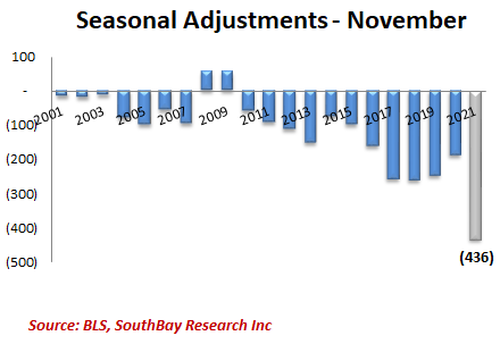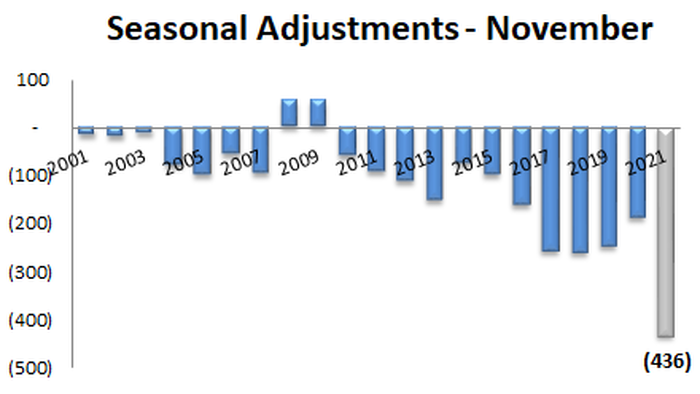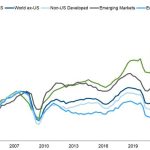In recent months, the BLS itself admitted that it has a big problem in applying its traditional, pre-covid seasonal adjustments to a data series that was thrown out of all seasonal norms by the covid pandemic. This is why teacher jobs yoyo-ed for months and why the BLS was forced to make substantial upward revisions for each of the past 6 months, with most deriving from a flawed seasonal factor revision.
Well, it appears that a big reason for today’s huge, 5-sigma miss in total payrolls…

… even as the rest of the report was surprisingly solid, with the unemployment rate dropping, the number of unemployed workers sliding, and the household survey showing more than 1.1 million employed Americans, is that the BLS once again used a flawed seasonal adjustment which will prompt a sharp upward revision to the November print when it is revised next month.
As Southbay Research explains further today,
During COVID, the BLS admitted to two significant failures that led to substantial data distortion:
- Data collection: in 2020, the BLS discovered that their new COVID-created remote sampling incorrectly classified some payroll, resulting in underreporting hundreds of thousands of workers.
- Seasonal Adjustments: The BLS used their traditional methodology of applying a ratio to the raw Non Seasonally Adjusted data, which overstated job losses
The seasonal adjustment factor is important: The Dept of Labor recognized the problem with the weekly Jobless Claims, where they also applied a ratio multiplier. They shifted away from the multiplier and began using absolute numbers as of August 29, 2020
Why does it matter? The answer is obvious: the SA is supposed to remove the ‘normal’ seasonal labor swings. For example, we know bad weather typically hits construction in November, so layoffs in that sector are expected and smoothed out.
So historically speaking, ex recessionary periods, November sees 200K~300K in additional hiring. Basically the seasonal shopping hiring. And so we see an equivalent level of offsetting Seasonal Adjustment. Except for this November:

The implications: i) hiring, as hinted by the Household model, is quite strong but is hidden by model mechanics; and ii) more importantly, the faulty application of seasonal adjustment methodology lowered the November payrolls print by at least 200K; or as SouthBay summarizes it, “Far from being a weak November” this was a pretty strong report.











